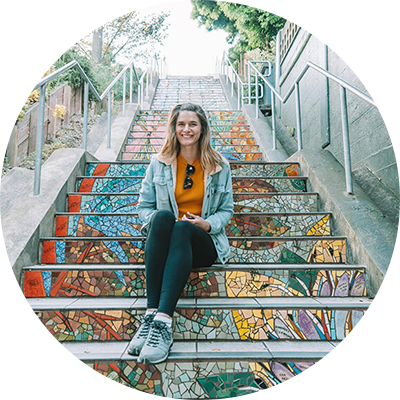Short on time? Our picks for the best backpacking rain poncho are the Cedar Tree Packa and the OneTigris TENTSFORMER Rain Poncho.
The best backpacking rain ponchos for every type of outdoor adventure this year.
I don’t know about you, but I get unreasonably grumpy when I’m outside in the rain.
My backpack gets damp, I get cold, and the fun meter goes way down. Add rain to an overnight backpacking situation, and I’m pretty much done.
One way to keep your fun meter in the green and keep yourself dry is waterproof ponchos!
A backpacking poncho is designed to fit over your whole body and your backpack, so everything stays dry.
These are no flimsy plastic garbage bags, either. Waterproof ponchos for hiking have a long list of added features that make them comfortable, lightweight, and effective.
Below, I’ve listed the best rain ponchos for backpacking and any upcoming outdoor adventures you might have.
By the end of this article, you’ll also know the difference between waterproofing sprays used on ponchos and what to look for in a backpacking poncho.
Note: this post contains affiliate links, which help run this site at no extra cost to you so I can keep providing free travel advice and tips.
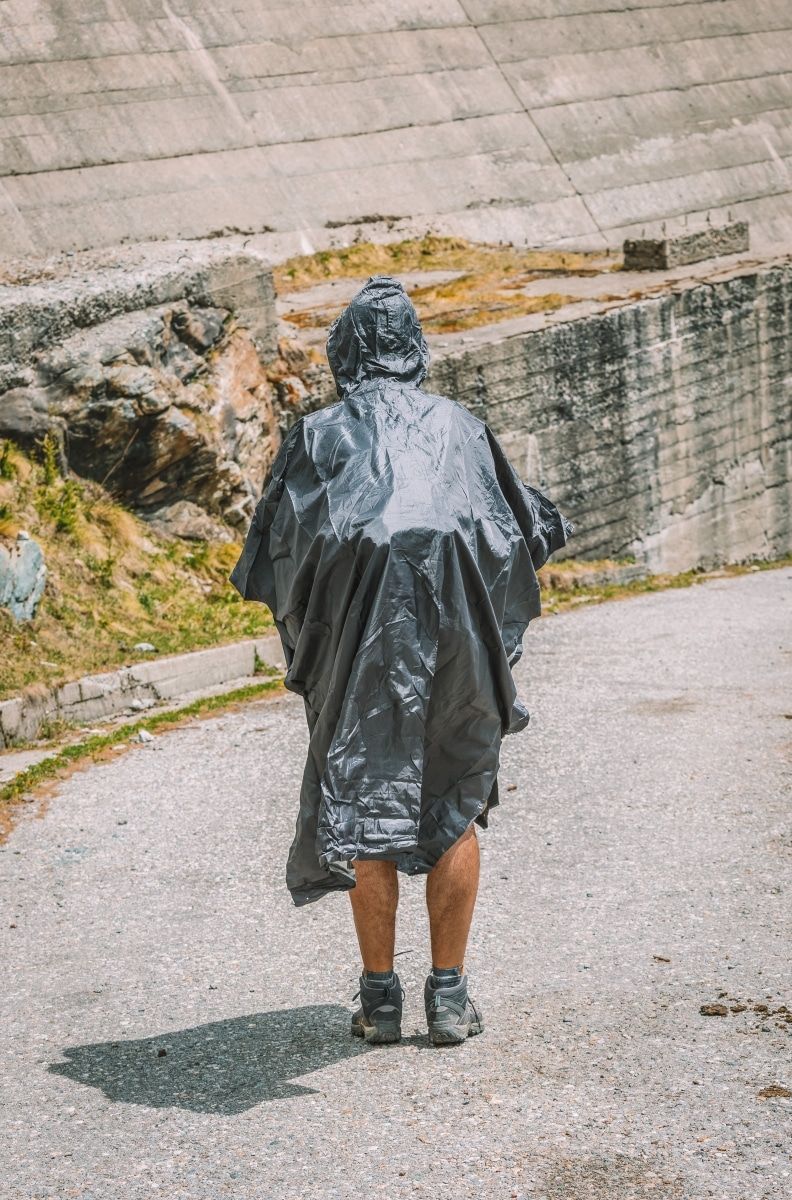
Short on Time? Here’s a Quick Look at Our Recommendations
- Outdoor Products Backpacker Poncho
- Cedar Tree Packa
- Hazard 4 Poncho Villa
- OneTigris TENTSFORMER Rain Poncho
- VUADE Hiking Backpack Poncho
- Mil-Tec RipStop Wet Weather Rain Poncho
- Anyoo Waterproof Rain Poncho
- Onewind Silnylon Ultralight
- Sea to Summit Ultra Sil Nano Poncho
- Frogg Toggs Ultra-Lite2 Poncho
- Rumpl NanoLoft Poncho
#1 Outdoor Products Backpacker Poncho
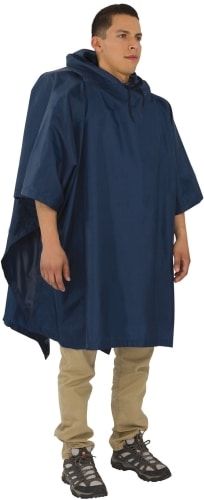
Our rating: 4/5
Weight: 10.7 oz
Material: polyurethane-coated polyester taffeta
Packed size: 55″ x 38.75″ (front) x 52.75″ (back)
Length: Mid-thigh
The Outdoor Products Backpacker Poncho is an excellent rain poncho for backpacking because it’s designed to hold large backpacks.
Rain ponchos for backpacking save you the pain of purchasing and packing a separate pack cover. Plus, they’re usually more waterproof than rain jackets.
This is a very light rain poncho that folds up into a mesh pouch so that it won’t mildew.
I really like this poncho overall, but I wish it had chest pockets. They’re excellent features on rain ponchos because they’re a convenient place to put a map or phone without having to dig around in your regular pockets and get things wet.
The hood on this poncho is anatomically shaped, which I love because I hate when hoods are way too big and just slide off all the time.
The hood also comes with a cinch cord to keep it tight around your face and web-tie cords at the corners to double as a rainfly.
What sets the Outdoor Products poncho apart from others on this list is that the extra-long backpack compartment folds and snaps away so you can wear it comfortably on a day hike.
As a backpacker, I ditched the Outdoor Products Multipurpose Poncho because the backpacking cut works just as well as any other ponchos for hiking
PROS
- Fits a backpack underneath
- Lightweight
- Hood drawstrings
- Converts into a rainfly
- Taped seams
CONS
- The back of the poncho drapes off of the backpack but doesn’t cover the back of your legs
#2 Cedar Tree Packa
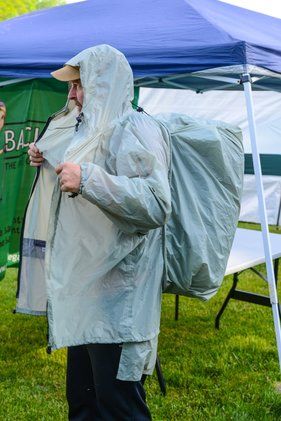
Our rating: 5/5
Weight: 9.20 oz
Material: 15-40D coated nylon
Packed size: 10’’ x 12’’
Length: Top of pants
Straight up, I love the Cedar Tree Packa, and you can tell this rainproof hiking poncho was made by some serious backpacking nerds (aka, my people).
The Packa comes with three different fabric options going from 15D and 20D silicone-coated nylon to a 40D breathable specialty fabric made by Polymax.
They are upfront in saying that the two lighter fabrics (the 15D and 20D) are not breathable but have heavy-duty waterproof ratings (2000mm).
The heaviest-weight fabric (40D) is breathable and still performs well in the rain but doesn’t have a millimeter rating to go with it.
There are a few other nuances that differ among the three fabric choices as well.
For example, the 30D and 40D fabrics have taped seams, but the 15D doesn’t. But they’re not leaving you “out to dry,” so to speak – the 15D poncho is made with a cotton blend thread that swells when wet to keep water out.
Ok, now the thing I like about this backpacking poncho the most: the design.
Packa rain ponchos are designed to be a pack cover first and foremost. You strap it on your pack and let it be.
If rain starts to come down, you can reach over your head to loosen the hood, sleeves, and body of the poncho. The poncho will still cover your pack, but you don’t have to take it off to stay dry.
The Packa also fits a little more snugly than a typical backpacking poncho, which keeps it from blowing around in heavy wind.
Additionally, the Packa has a front pocket and pit zips for ventilation. And it has a drawstring hood, bottom hem, and sleeves, which make it easy to customize for your particular size.
The packed size isn’t totally clear for the Packa, but it’s around 10’’ x 12’’, and it can also make a great backpacking pillow.
Finally, if I’m being picky, I only wish it had a firm brim to help keep the rain off my face better.
PROS
- Different material options
- Fits well in high wind
- Drawstrings on everything
- Don’t have to take your pack off to put it on
- Emphasizes good ventilation
CONS
- Leaves legs exposed
- No firm brim on hood
- Large packed size
#3 Hazard 4 Poncho Villa
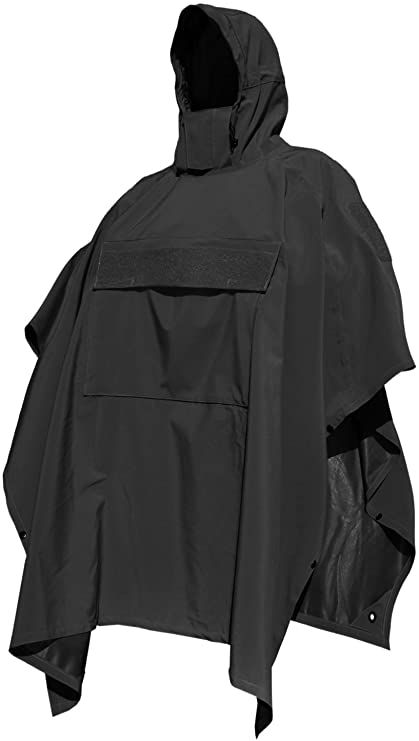
Our rating: 4/5
Weight: 2.3 lbs
Material: 86% polyester, 14% spandex; liner is 100% polyester
Packed size: 13” x 11.2” x 2.2”
Length: Mid-thigh
The Hazard 4 Poncho Villa is a re-done version of an old-style military poncho, and the new version keeps a few remnants of that history.
The Poncho Villa has a velcro patch where you can put an ID and is designed to fit loosely so that you can easily put a backpack underneath it.
The poncho fully covers the upper body and your upper legs and has grommets around the edge, making it usable as an emergency shelter or tarp.
The hood also has a cinch on it (in two places!) and has a few extra side snaps to make it fit more snugly in windy weather.
I like that this rain poncho has the option of a fleece liner, but note that a fleece liner would be pretty bulky when packed.
One thing to note is that although this poncho has taped seams on the entire garment, it’s best suited for light rain.
The poncho has a somewhat larger packed size, but it still folds into its large chest pocket. With that said, the Poncho Villa is a little on the heavy side for backpacking at 2.3 lbs.
PROS
- Optional fleece liner available
- Full coverage for backpack
- Hood with brim
- Multi-use (shelter, tarpaulin)
- Stuff sack
CONS
- Best in light rain
- Heavy
- Large packed size
#4 OneTigris TENTSFORMER Rain Poncho
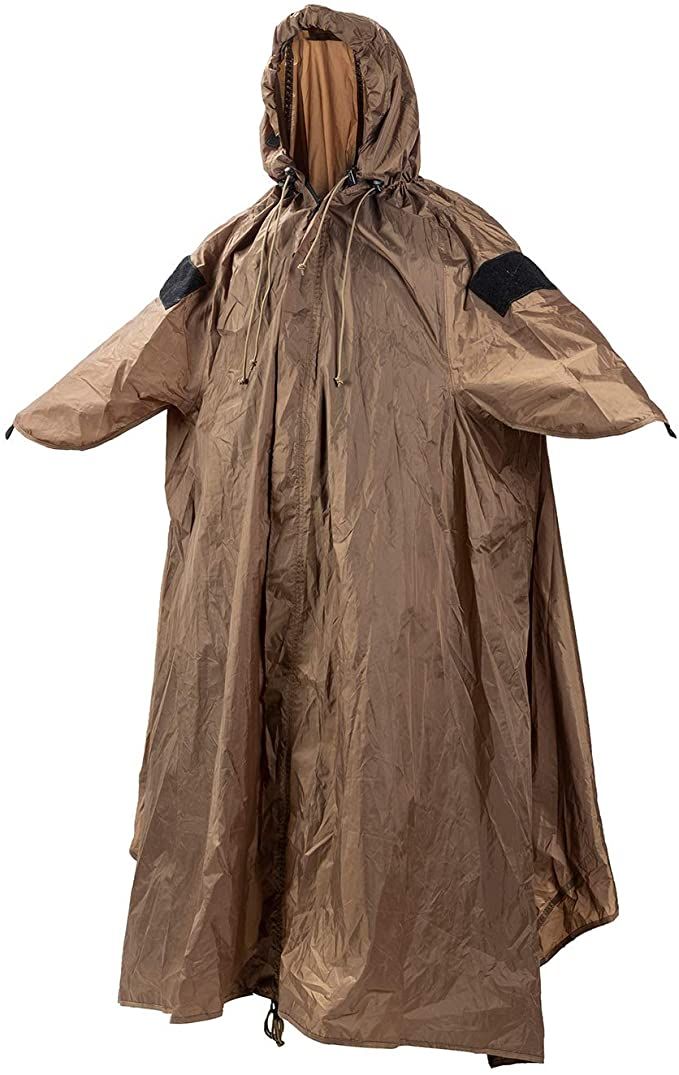
Our rating: 4.5/5
Weight: 22.5 oz
Material: 75D ripstop nylon with 1500mm waterproof rating
Packed size: 4.7’’ x 4.7’’ x 10.6’’
Length: Mid-calf
The OneTigris Tentsformer Rain Poncho is another tactical-style backpacking poncho designed with particularly appealing features for bushcrafters (aka hardcore survivalists).
And even if you’re not a bushcrafter, this is still a very good backpacking or hiking poncho.
As a tactical-style poncho, it has velcro on the sleeves to attach a patch or badge.
And one really neat thing about this poncho is that it can double as a simple emergency shelter, sleeping bag cover, or ground cover, and they even give you some tent stakes and guy lines.
The poncho is very lightweight, only 22.5 oz, but has an excellent material strength rating.
75D is very heavy-duty when it comes to rain ponchos, and the nylon has been treated with a polyurethane (PU) coating, giving it a 1500mm waterproof rating.
The hood is also adjustable but doesn’t have a brim or a chest pocket.
One thing I especially like about this design is the leg length. It hits mid-calf on most people. I appreciate that amount of coverage because carrying rain pants into the backcountry is a pain.
One thing about the zippers on this poncho – hardware matters, people!
One of the world’s biggest and best zipper makers is YKK, and most outdoor gear makers using their zippers will brag about it. I know, nerdy, but details matter – and the OneTigris has YKK zippers!
Some of the cons of the OneTigris include the fact that it doesn’t have a chest pocket, and the sleeves are a little short. Also, since it can’t cinch (except around the hood), it may flap around a bit in high wind.
PROS
- Very durable material
- Doubles as a makeshift tent
- Adjustable hood
- Comes with pegs and guy lines
- Good leg coverage
CONS
- No chest pocket
- ¾ sleeves
- No cinches on the bottom or sleeves
#5 VUADE Hiking Backpack Poncho
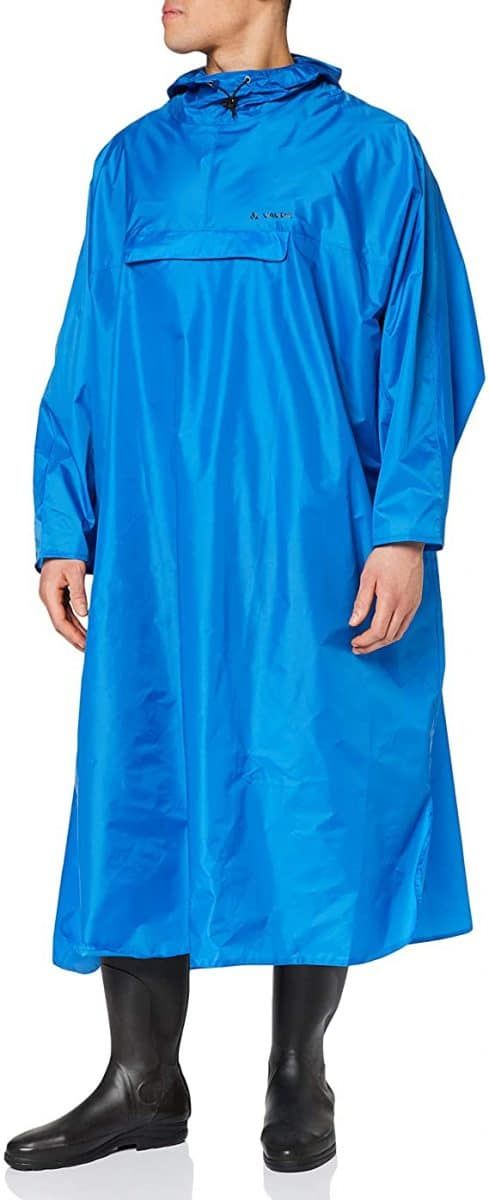
Our rating: 4.5/5
Weight: 15 oz
Material: 100% polyamide
Packed size: 12’’ x 10.9’’ x 1.1’’
Length: Mid-calf
The VUADE Hiking Backpack Poncho is the best waterproof hiking poncho for the environmentally conscious.
Vuade is a European brand that features a waterproofing method that doesn’t use harmful fluorocarbons (PFCs).
Simply put, PFCs are harmful to human health and the environment, but Vuade has transitioned its entire collection away from these artificial chemicals.
Vuade states that regular reapplication of a waterproofing spray is necessary, but frankly, that’s true for most waterproof products.
This backpacking poncho is waterproof, breathable, and suitable for heavy rain.
I couldn’t find the fabric specifications I usually look for when evaluating a high-quality rain poncho. However, in this case, I am letting that go since this is a European brand, and they may not use the exact measurements that Americans do.
The poncho also has long sleeves, an adjustable hood, and hits at mid-calf. Even better, since this is a loose-fitting poncho, you can use snaps between the legs to keep it from blowing in the wind. The poncho also has a front chest pocket, which you know I love for keeping my essentials within arm’s reach.
The Vuade rain poncho is roomy enough that you can fit a backpack underneath it or, if you have a large backpack, you can zip off the back to fit your backpack.
Lastly, this poncho is lightweight, coming in at just a few ounces, and can be packed into the chest pocket.
Vuade makes rain ponchos for both men and women and in various sizes and colors.
PROS
- Environmentally made
- Front pocket
- Drawstring hood
- Full body coverage
CONS
- Needs re-application of waterproofing spray
#6 Mil-Tec RipStop Wet Weather Rain Poncho
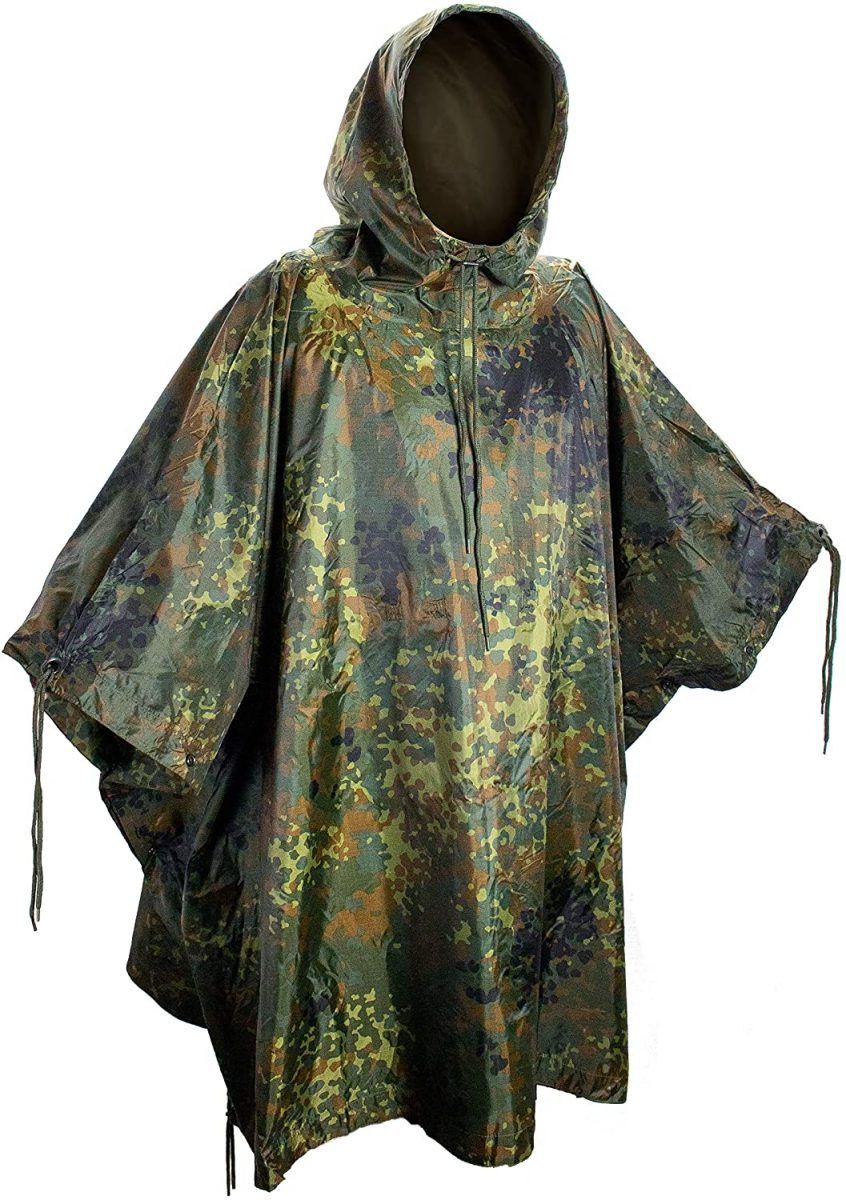
Our rating: 4/5
Weight: 1.7 lbs
Material: 100% polyester ripstop with 5000mm waterproof rating
Packed size: 8’’ x 10’’
Length: Mid-thigh
The Mil-Tec RipStop Wet Weather Rain Poncho is the best rain poncho for hiking and doing wildlife photography.
This poncho is traditionally designed by Sturm, a European military surplus store, so the intended audience for this product is hardcore outdoor people.
However, the color pattern on this military rain poncho – drab olive or camouflage – is also great for sitting still and blending in while doing wildlife photography!
Some ponchos can be noisy (crinkly) when you move, but this one isn’t very loud – another essential element for viewing wildlife.
This is a great addition to your rain gear because it’s another product that can double as a simple emergency shelter.
It also has high-quality grommets along the edge. With a couple of lightweight tent stakes and some paracord, you could easily make it into an awning.
Additionally, this poncho has a drawstring hood and the waterproof rating on it is outstanding at 5000mm.
The waterproof rating on this poncho is excellent, but take note of the product used.
Rather than a waterproof polyurethane (PU) coating, it uses polyvinyl chloride (PVC), which doesn’t stand up quite as well to abrasion and oil as PU coating does.
Finally, this rain poncho for hiking won’t cost you an arm and a leg. It’s one of the more reasonably priced ponchos made from quality materials.
I couldn’t find the packed size dimensions for this poncho, but I’d estimate it to be about 8’ ’x 10’,’ which is roughly equivalent to many of the other ponchos on the list.
PROS
- Very high waterproof rating
- Multipurpose poncho
- Reasonably priced
- Comes with a stuff sack
CONS
- Heavy
- PVC coating rather than PU
- Packed size not listed
#7 Anyoo Waterproof Rain Poncho
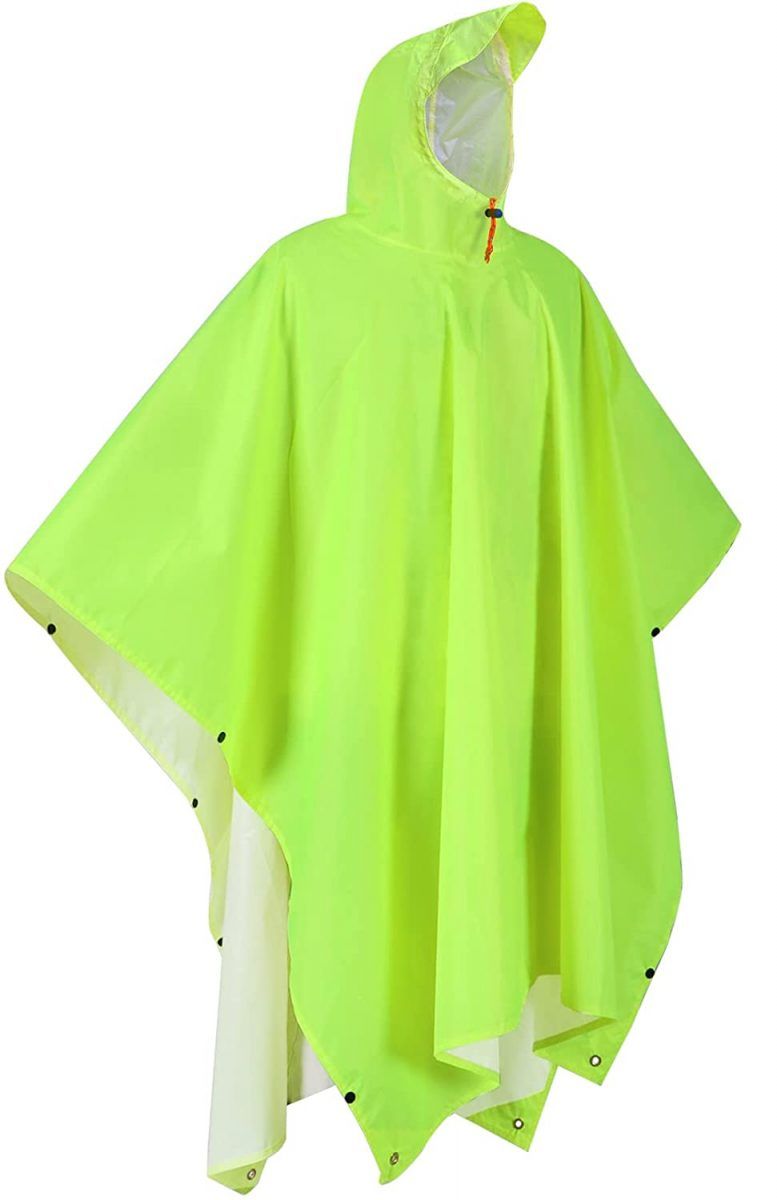
Our rating: 4/5
Weight: 9 oz
Material: 100% ripstop polyester, 3000mm
Packed size: 9’’ x 3’’
Length: Knees
The Anyoo Waterproof Rain Poncho is the best waterproof poncho for those on a budget. This is a simple, few-frills, lightweight, waterproof poncho that will serve you well in a pinch.
This poncho has waterproof fabric rated at 3000mm, which is an excellent rating.
They label it as PU 3000mm, which means it’s coated with polyurethane. However, other product descriptors say it’s coated with PVC, which is a slightly lower-quality waterproofing product.
The fabric itself is 210T (thread) ripstop polyester, and again, polyester is a cheaper fabric than nylon. That said, I still think this is an excellent addition to your rain gear stash.
It has a very long, rigid brim on the hood, which I love because you need a brim or a baseball cap to keep the rain off your face. The hood is also adjustable, and the total weight is very low at just 9 oz.
This is a multi-use poncho with grommets along the edges. It doesn’t have sleeves, but it has snaps along the sides so you can batten it down if the wind gets up.
Most importantly, the Anyoo Waterproof Rain Poncho is big enough to have a backpack underneath, and the price is excellent.
This is one of the more affordable ponchos on this list and would be great for kids or concertgoers as well as hikers.
PROS
- Inexpensive
- Snaps on the side
- Grommets for multi-use
- High waterproof rating
- Lightweight
CONS
- PVC waterproof coating
- Polyester fabric
#8 Onewind Silnylon Ultralight
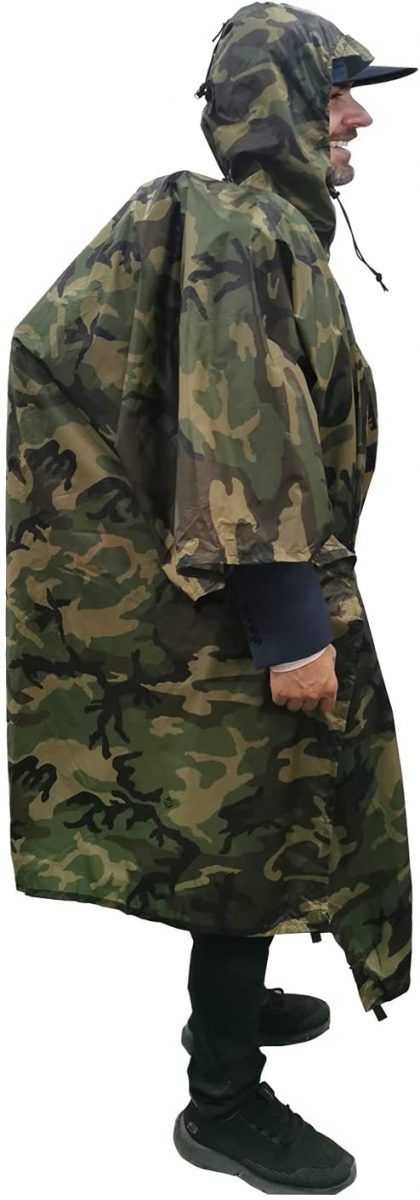
Our rating: 4.5/5
Weight: 7.7 oz
Material: 15D Ripstop silnylon
Packed size: 2.75’’ x 7’’
Length: Mid-calf or ankles
The Onewind Silnylon Ultralight is a great rain poncho for backpacking because of its small pack size, and, as the name suggests, it’s very lightweight.
This rain poncho has an adjustable hood with a high neck and is made of high-quality 15D nylon treated with silicone.
As with other waterproof ponchos, the design is made more effective with loops and hooks around the bottom and arms so you can make sleeves and keep them closer to your body.
This piece of rain gear also has velcro on it, which can be a double-edged sword.
I have a few shirts that have mini-tears in them now due to the velcro fasteners on the sleeves of my jacket. Onewind avoids this problem by using a “baby soft” velcro, which means it won’t tear your clothes.
The overall shape of the poncho is a big rectangle, and you can use it as an emergency shelter, sleeping bag cover, or ground cloth too.
To use it as a shelter, you simply twist the hood around itself so water can’t get through, and then you have a solid tarp to use for a variety of purposes.
The poncho is loose enough to accommodate a big backpack, up to 70L. This is a unisex rain poncho, so ladies, make sure you order a size smaller!
I couldn’t find a millimeter rating for the waterproof material. However, based on the fabric description (silnylon), I know it must be made of nylon (which is good quality) and likely treated with silicone, which is a good waterproofing material.
PROS
- Adjustable hood
- Velcro fasteners on the side
- Lightweight
- Small pack size
CONS
- No waterproof rating listed
#9 Sea to Summit Ultra Sil Nano Poncho

Our rating: 4.5/5
Weight: 8.1 oz
Material: 15D Ultra-Sil Nano fabric, 1200 mm
Packed size: 3’’ x 5.25’’
Length: Knees
The Sea to Summit Ultra Sil Nano Poncho is another contender for the best backpacking poncho. It packs down incredibly small and is very lightweight.
The Sea to Summit Ultra Sil Nano is made from ultra-sil nano fabric, which means the nylon has been “siliconized” and treated with a polyurethane waterproof coating. The resulting waterproof rating is 12000mm.
Remember that fabric must be at least 1000mm to be considered a waterproof material.
This type of fabric and level of weather protection make it small and lightweight, and as an additional bonus, lightweight fabric like this tends to be more breathable. The tradeoff is that it’s going to suit you best in lighter rain conditions.
This multipurpose rain poncho can be made into a two-person shelter, and it has snaps on the side for windy conditions.
The Sea to Summit poncho is a unisex, one-size rain poncho, so it may run slightly big on petite women.
PROS
- Snaps on the side
- Double-stitched, tape sealed seams
- Fits a large backpack
- Multipurpose
CONS
- Expensive
- Best in light rain
#10 Frogg Toggs Ultra-Lite2 Poncho
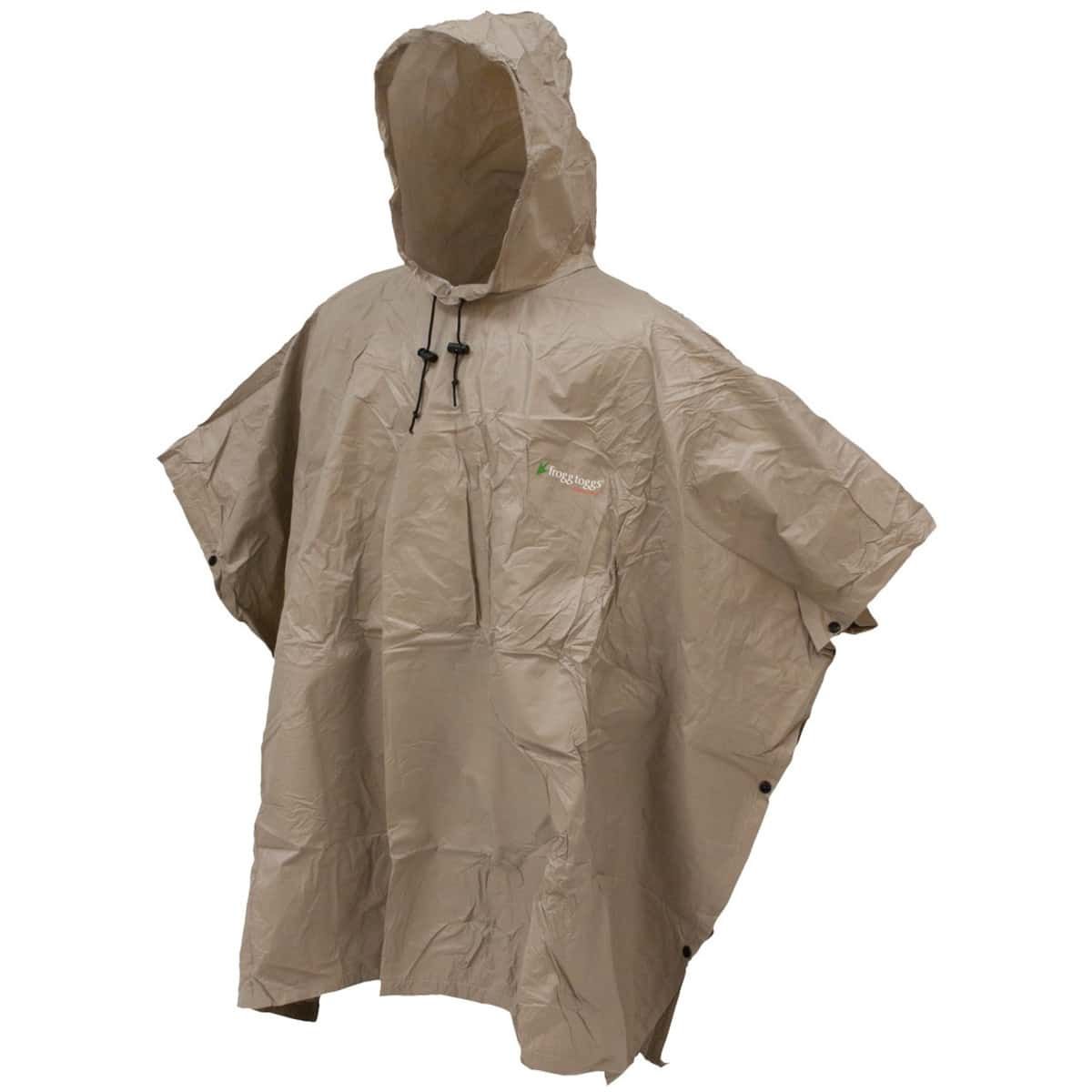
Our rating: 4/5
Weight: 9 oz
Material: 3 layers including polyester, DriPore Gen 2, and Nonwoven polypro
Packed size: Not listed
Length: Mid-thigh
The Frogg Toggs Ultra-Lite2 is the best camping rain poncho for families because it’s an excellent combo of price and performance.
I also think the Frogg Toggs Ultra-Lite is good for families because they boast that it’s “blood resistant.” I find that a slightly weird thing to brag about and I think the statement is geared toward fishermen. But, blood happens in a family with lots of outdoorsy and adventurous kids.
This is a very lightweight poncho at just nine ounces. You’d have to pay for an expensive poncho to get one too much lighter than that.
Although the product listing says this is a men’s poncho, it’s actually unisex. The fabric is made of three layers, and each layer provides a different benefit.
The outer layer is polyester, which is pretty standard on lower-cost ponchos. The middle layer is a proprietary material called DriPore Gen 2, which is fully waterproof, windproof, and breathable.
The third layer is a nonwoven polypro, which is short for polypropylene. Polypropylene isn’t woven; it’s poured. The resin-based material creates a porous matrix that is still breathable but water-resistant.
And, if you find that these fancy materials don’t live up to their hype for some reason, Frogg Toggs offers a one-year warranty.
Lastly, the simple design has an adjustable hood with snaps on the sides to keep the wind at bay.
That said, the snaps aren’t always the most durable and sometimes pop open in the intermediate wind.
PROS
- Affordable price
- Snaps on the side
- Stuff sack
- Lightweight
- One year warranty
CONS
- Low-quality snaps
- Packed size not listed
#11 Rumpl NanoLoft Poncho
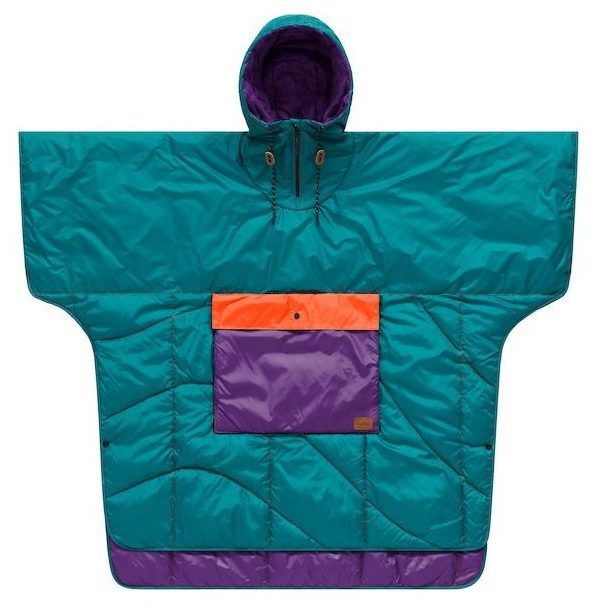
Our rating: 4/5
Weight: 2.0 lbs
Material: 100% recycled 30D polyester shell with NanoLoft insulation
Packed size: 12’’ x 12’’
Length: Mid-thigh
The Rumpl NanoLoft Poncho is very different from the other ponchos on this list, but hey, I had to make sure you had a good variety.
This insulated poncho is made of polyester, making it one of the best rain ponchos for chronically chilly women (like me!).
The front of the Rumpl NanoLoft Poncho has a large pocket, and the whole thing is machine washable. The poncho packs up into a built-in stuff sack and can be folded into a pillow.
Another thing that makes this different from the other ponchos on this list is that it’s a stylish rain poncho!
The colors and design are inspired by an 80’s ski jacket, and let’s be real, those are having a moment right now.
Besides the fun colors, it has a hidden insulated drink pocket and is made of 100% recycled materials.
One of the downsides of this poncho is the sleeve length. They are about three-quarter’s length, which isn’t ideal. It’s also a bit heavy for those looking for ultralight camping, and the packed size isn’t tiny (which is fine if you use it as a pillow).
Finally, while this rain poncho excels in windy conditions, it’s not fully waterproof (just water-resistant), making it best for light weather protection only.
PROS
- Stylish rain poncho
- Insulated
- Large front pocket
- Machine washable
- Doubles as a pillow
CONS
- ¾ sleeves
- Heavy
- Only water-resistant
Buying Guide: How to Choose the Best Rain Poncho for Backpacking
What to Look for in a Backpacking Rain Poncho
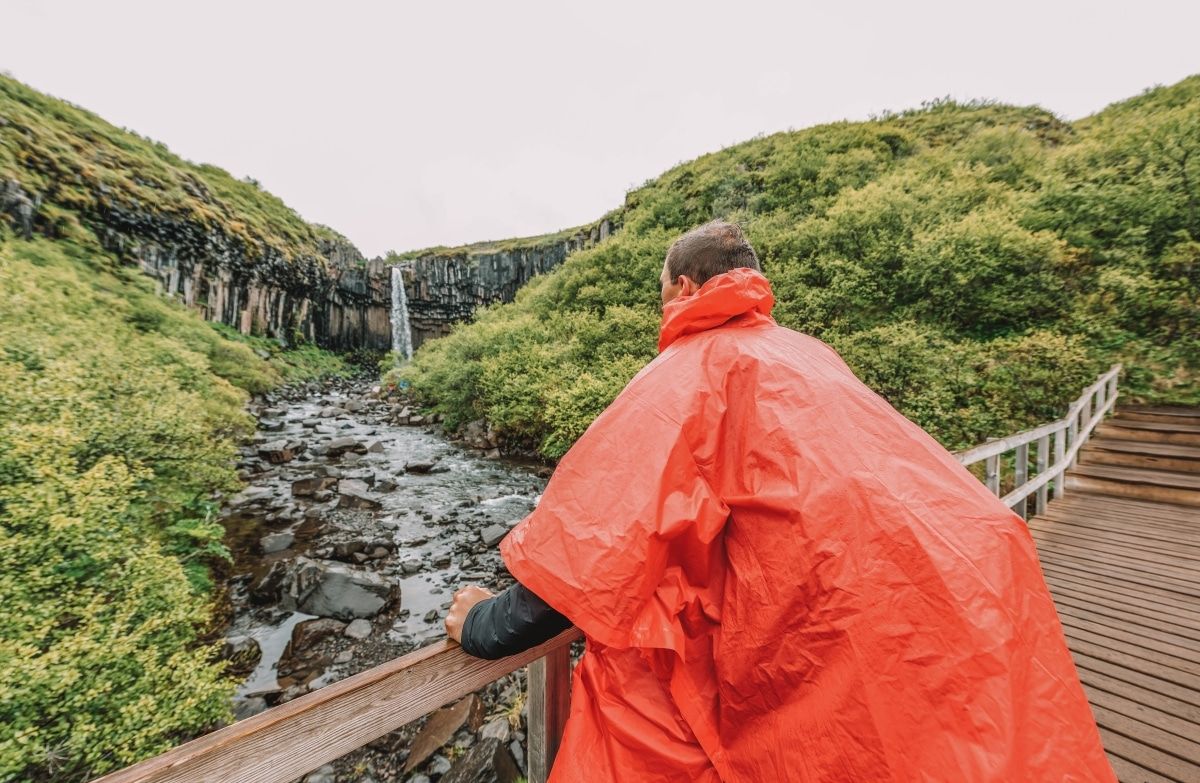
Waterproof Rating
Waterproof ratings can be confusing. You can see our other articles for more information on understanding camping gear fabric ratings, such as our guide on how to waterproof a tent.
When it comes to rain ponchos, the two most essential rating specs are denier rating (D), explained below, millimeter rating, and what the material was treated with.
Many waterproof rain ponchos are treated with either a silicone, polyurethane (PU), polyether urethane (PE), and/or polyvinyl chloride (PVC) coating to make them more waterproof.
The rating given to treated material is in millimeters (mm) and measures how many millimeters of water can sit on the fabric before water starts to leak in.
Look for ratings over 1000 millimeters when shopping for fully waterproof rain protection (that goes for tent materials too).
The best rain ponchos will also clearly state what their fabric ratings are!
Keep in mind that the most waterproof poncho on the market may not be the best poncho. A larger millimeter rating may mean better rain protection, but it can be a tradeoff for breathability.
Material
It can be hard to judge the material of a waterproof poncho because many manufacturers use proprietary materials types/names that are designed to sound cool and fancy. No matter what type of material they’re using, look at the denier rating.
The denier rating (D) of a fabric is the thickness of the strands of material. Silk has a denier rating of 1. Many high-quality tents have ratings of 60D or larger.
For a waterproof poncho, look for a rating of at least 15D. Lightweight rain ponchos will often have lower denier ratings, but that isn’t necessarily bad.
“Waterproof breathable fabrics” is almost a misnomer, and it can be challenging to find a balance between the two.
As with the millimeter rating, the higher the denier, the bulkier the material, and the less breathable it will be. You know what this feels like if you’ve ever made the mistake of wearing rain jackets over tank tops in high humidity.
Size/Fit
For backpacking or hiking ponchos, I recommend long sleeves and for it to hit at least mid-thigh. That way, you’ll have the most coverage all over your body.
If you’re a particularly large or small person, make sure the poncho comes in a size that works for you; otherwise, it will either be a tripping hazard or completely ineffective.
Pockets
If you’ve read any of my other articles, you know how jazzed I get about pockets on my camping gear. The same goes for rain ponchos.
Having a big front (waterproof) chest pocket is clutch.
It’s a huge pain to search around under a poncho for your map/compass/phone/snacks/whatever. Keeping it on your chest is way more convenient.
Other Features
Other pluses to look for in a waterproof rain poncho include:
- Storage bag/stuff sack
- Backpack clip, so it can live on the outside of your pack
- Poncho liner; adds a layer of insulation
- Double-stitched seams
- Heat-sealed seams
- Pit zips; zippers near your pits for ventilation!
What’s the difference between all the different waterproofing sprays?
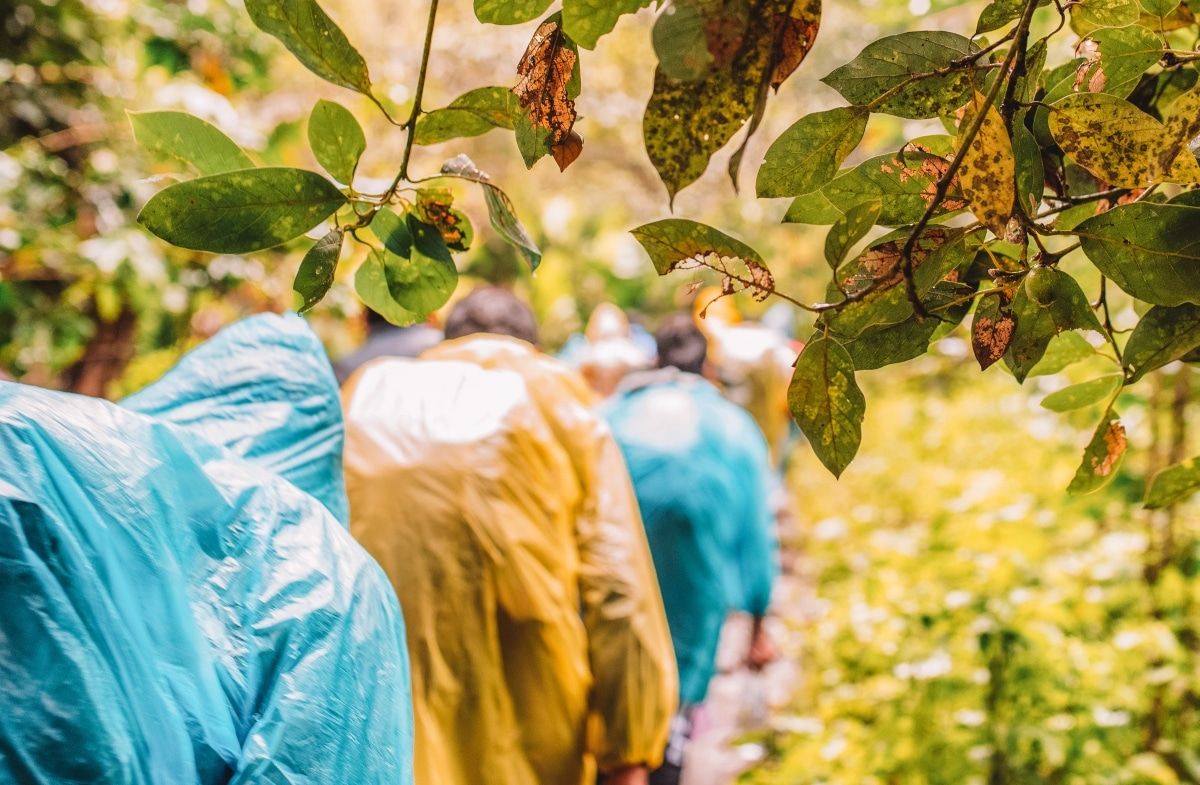
It probably goes without saying, but each chemical used to waterproof outdoor gear has different strengths and weaknesses.
Most ponchos are entirely waterproof when you purchase them, but whether they’ll stay that way depends on what type of coating was used for the finish.
Polyurethane (PU) Polyether urethane (PE)
Polyurethane (PU) stands up very well against abrasions, other chemicals, and oil (think food stains).
Polyurethane waterproofing spray is very commonly used on outdoor gear and ponchos. In fact, it’s probably the most common one I see.
Polyurethane is inexpensive and can be reapplied in many coatings to make the fabric very, very waterproof. It can also be combined with other chemicals that provide fire retardancy to fabrics.
Despite its popularity, it doesn’t last forever and will naturally degrade after several years.
Additionally, items treated with PU are more liable to tear as the PU coating brings down their tear strength.
However, this shouldn’t be a problem for materials that are already very strong or durable (think materials with high denier ratings).
Polyether urethane (PE)
Polyether urethane (PE) is similar to PU but is less commonly used. For the purposes of this explanation, just know that if you see PE in a fabric description, it acts similarly to PU.
Polyvinyl chloride (PVC)
Polyvinyl chloride (PVC) stands up well against abrasion and other chemicals but poorly against oil stains.
It’s generally a less durable coating than PU and is sometimes used on bargain items.
Silicone
Silicone is another common spray used to waterproof materials and is the gold standard for waterproofing.
You may be familiar with it from non-stick cookware.
Silicone doesn’t naturally break down the way PU and PE do and is highly water-resistant (hydrophobic). Because it’s so hydrophobic, it’s also very mildew-resistant.
Also, unlike PU and PE, silicone coatings actually make fabric stronger, not weaker.
Sometimes Silicone is combined with PU and you’ll see it abbreviated sil/PU. One side of the fabric is often treated with PU and the other with silicone.
Other names you may run into are silnylon (nylon treated with silicone). Fabric treated with just silicone will technically be described as sil/sil.
The downsides to sil/sil fabrics are that they’re more expensive than sil/PU or PU fabrics alone, and it’s hard to tape the seams properly. They’re so non-stick, it’s hard to apply other coatings (aka fire retardant chemicals) to them.
How to Care for Backpacking Rain Ponchos
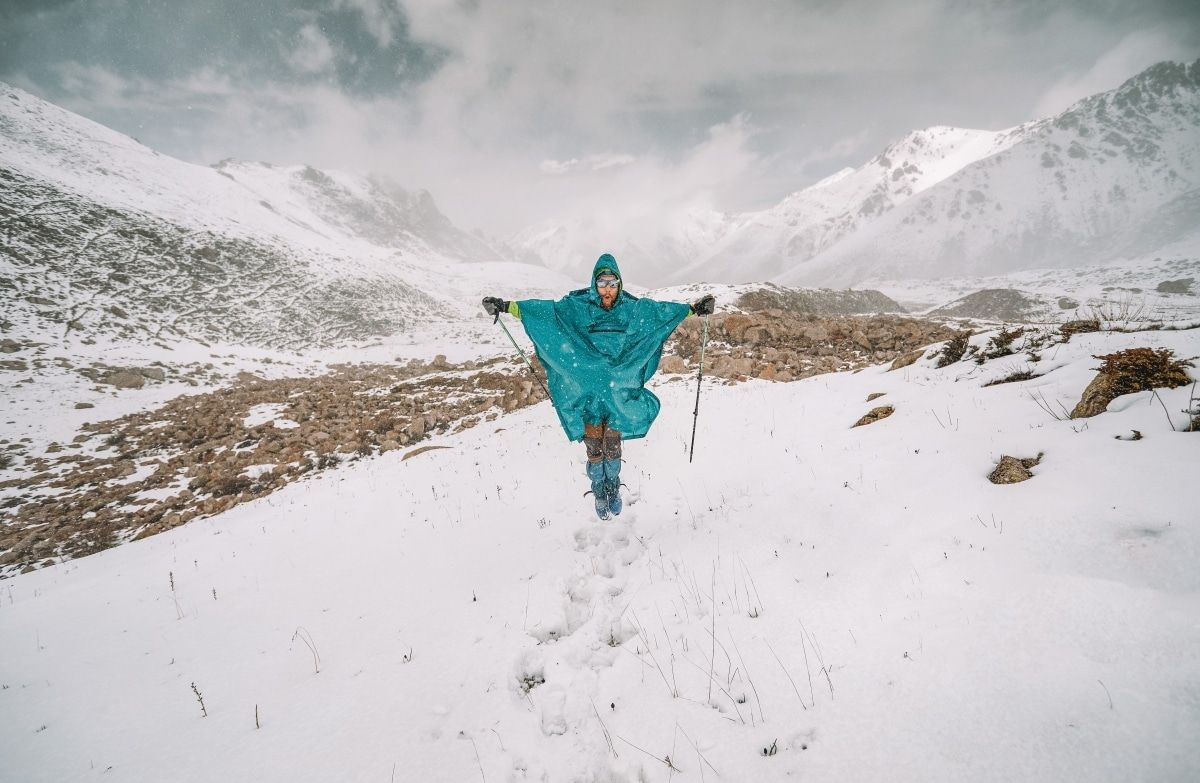
The most important piece of care instruction is to follow the manufacturer’s instructions. Different waterproof coatings have different care specifications.
Below I’ll give you some general guidelines for cleaning waterproof items (this includes tents too).
Never machine wash waterproof ponchos (or rain jackets, for that matter).
Even the best rain poncho on the market can’t withstand the agitation of a machine wash cycle.
The waterproof coating on outdoor gear is delicate, and even with excellent care, will begin to flake off or become less waterproof over time.
Rather than machine washing, hand wash rain ponchos to preserve the chemical treatment.
Use a gentle, eco-friendly soap. Avoid detergents!
Using harsh chemicals will ruin the finish on your poncho. Instead, opt for a mixture of water and vinegar or a mild detergent.
Use a microfiber cloth
If you don’t have a microfiber cloth, use a soft wash rag or anything that isn’t too abrasive. A dish sponge may work too if you don’t use the scrubby portion.
Line-dry your poncho
Don’t lovingly clean your poncho and then toss it in the dryer. The high heat will kill the finish. Instead, line-dry the poncho to let it dry naturally.
Types of Backpacking Rain Ponchos
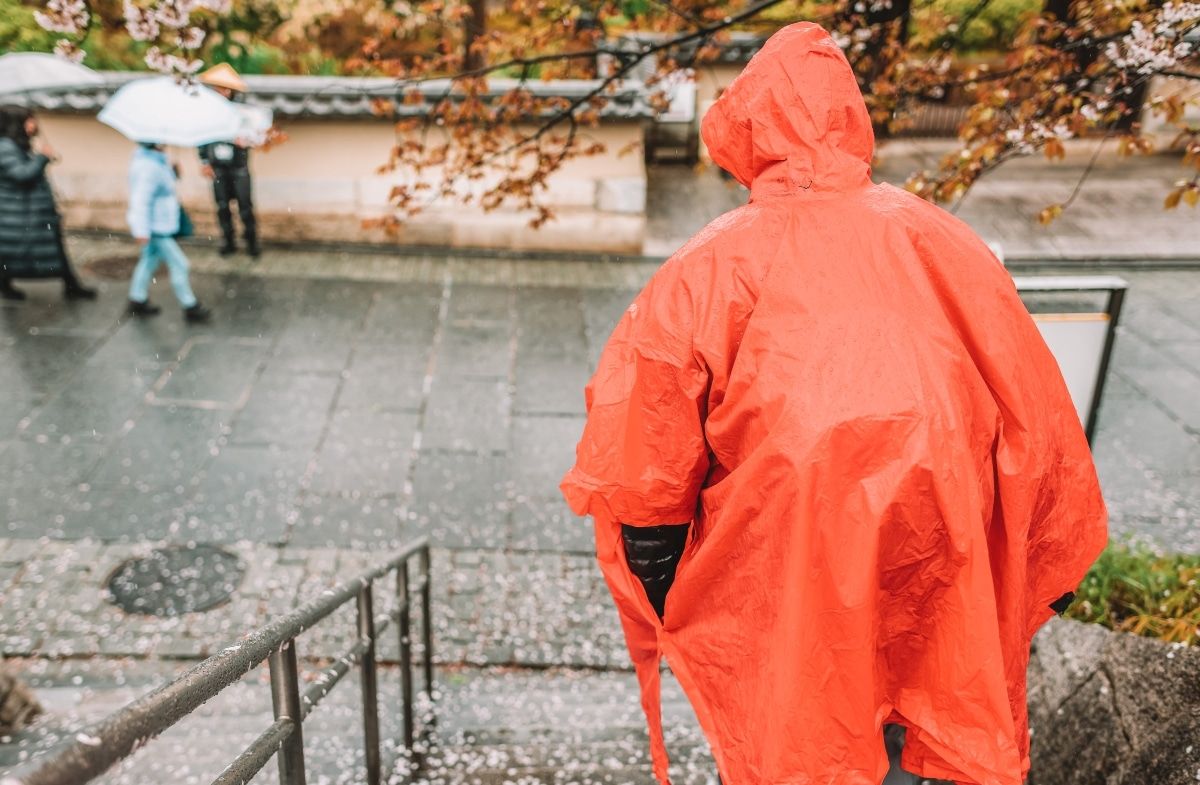
Military Style Ponchos
Military or tactical style packable rain ponchos are often designed to be multi-use garments.
They have metal grommets along the border that you can string paracord through to make a simple shelter.
They usually come in drab colors or camouflage and sometimes have velcro badge patches on the arms or chest. They’re still typically big enough to fit backpacks underneath.
These are best for hunters or wildlife photographers but still great for regular hikers and backpackers.
Standard Backpacking Ponchos
Backpacking ponchos are similar to military-style ponchos, except they sometimes come as ultralight and can pack down into much smaller sizes.
Backpacking ponchos should fit even the biggest backpacks underneath them, and they’re best for hikers, travelers, and backpackers.
FAQs About Backpacking Rain Ponchos
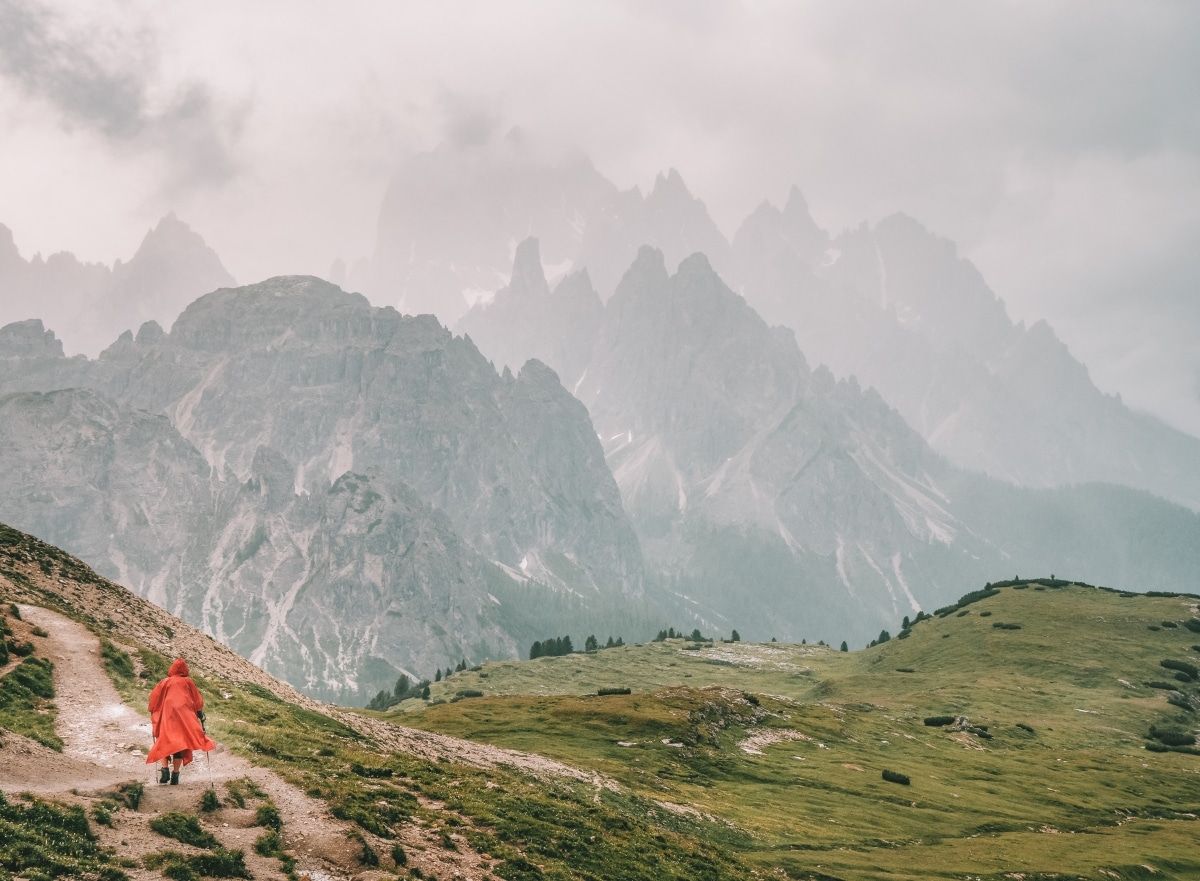
Are rain ponchos any good?
Yes! There are many excellent rain ponchos on the market that provide excellent protection from wet weather.
What’s the difference between a poncho and a raincoat?
The difference between a backpacking poncho vs. a rain jacket is fairly straightforward.
A rain jacket is a form-fitting, often heavy-duty jacket that just covers your upper body, arms, and head.
A backpacking poncho is a large, loose-fitting garment that covers your upper body, arms, head, and thighs and is loose enough to accommodate a backpack.
The best backpacking rain gear for you will depend on the type of trip you’re taking.
I often go out on day trips with just a rain jacket and pack cover (if rain is forecasted), and I’m just fine. However, I would go with a poncho for backpacking trips with rain forecasted.
Is a poncho or raincoat better for backpacking?
A poncho is better for backpacking than a raincoat for a few reasons. By being bigger and covering more of your body, Ponchos will help keep more of you dry.
Ponchos are also often lighter and pack down to a smaller size than rain jackets. Most lightweight ponchos are designed so you can put your backpack underneath them too.
One downside to most lightweight rain ponchos is that they can flap around in heavy rain and high wind.
You can avoid this by getting a durable poncho with cinches around the bottom and an adjustable hood.
Raincoats can be bulkier and heavier than ponchos, meaning they won’t pack down as small as some ponchos.
A heavy-duty rain jacket is form-fitting and will reduce the ventilation you can get with a heavy pack on.
This is important to consider. I’ve been backpacking before where, although my rain jacket kept me dry on the outside, I was sweating so much under my coat it basically didn’t matter.
Finally, you’d also need to carry a separate backpack cover to keep your pack dry if you only went out with a rain jacket.
What is the best material for a rain poncho?
The best hiking rain poncho is often made with nylon, while cheaper ponchos are usually made of polyester.
Keep in mind the material is just one component of how your poncho performs.
The waterproof spray applied to the poncho will also make a huge difference in how the poncho stands up.
How much do backpacking rain ponchos cost?
A good, lightweight rain poncho for backpacking can range anywhere from $20 to over $100.
How do I know what size rain poncho to get?
Most rain ponchos are one size fits all; however, if your poncho comes in various sizes, look at the sizing chart provided by the manufacturer.
Keep in mind that rain ponchos will not be stylish (well, I guess that depends on your definition of style) or form-fitting, so most of the time, an exact size isn’t needed.
Conclusion: Our Pick for the Best Rain Poncho for Backpacking
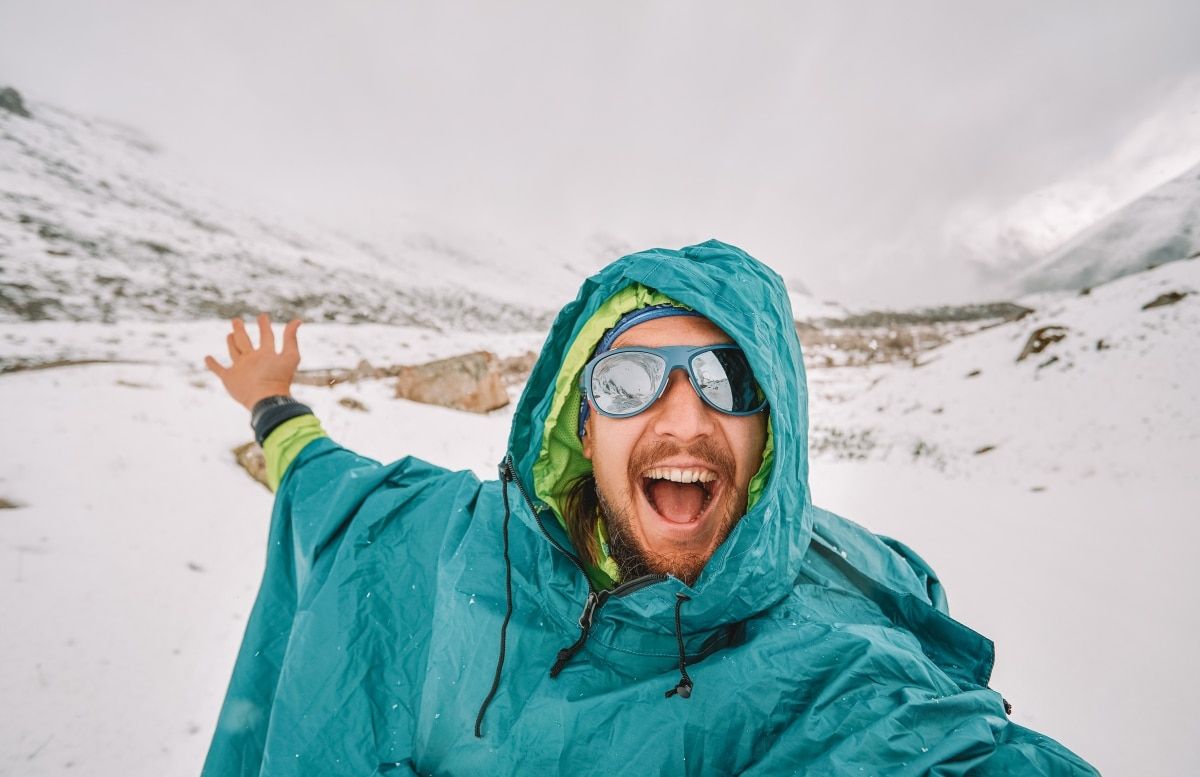
Our top pick for the best backpacking rain poncho is the Cedar Tree Packa.
The design of the Packa is unique in that it goes over your pack most of the time, and when you need to put it on your body, you can do so without taking your gear off.
I also rate the Packa as the best backpacking poncho because it comes in various waterproof levels and sizes, so you can customize what you need for your rain poncho.
Now, all of this said, I understand if you’re in a hurry and searching for an Amazon pick.
The OneTigris TENTSFORMER Rain Ponchos are the best rain ponchos on Amazon for backpackers.
ABOUT THE AUTHOR

Meredith Dennis
Meredith is a biologist and writer based in California’s Sierra Nevada. She has lived in 6 states as a biologist, so her intel on hiking and camping is *chef’s kiss* next level. One of her earliest camping memories was being too scared to find a bathroom at night on a family camping trip. Thankfully, she’s come a long way since then and she can help you get there too!
Looking for outdoor gear recommendations? Check out our related posts below!
Best Waterproof Tents for Heavy Rain
Best Waterproof Walking Shoes for Women
Best Dog Backpack Carriers for Hiking
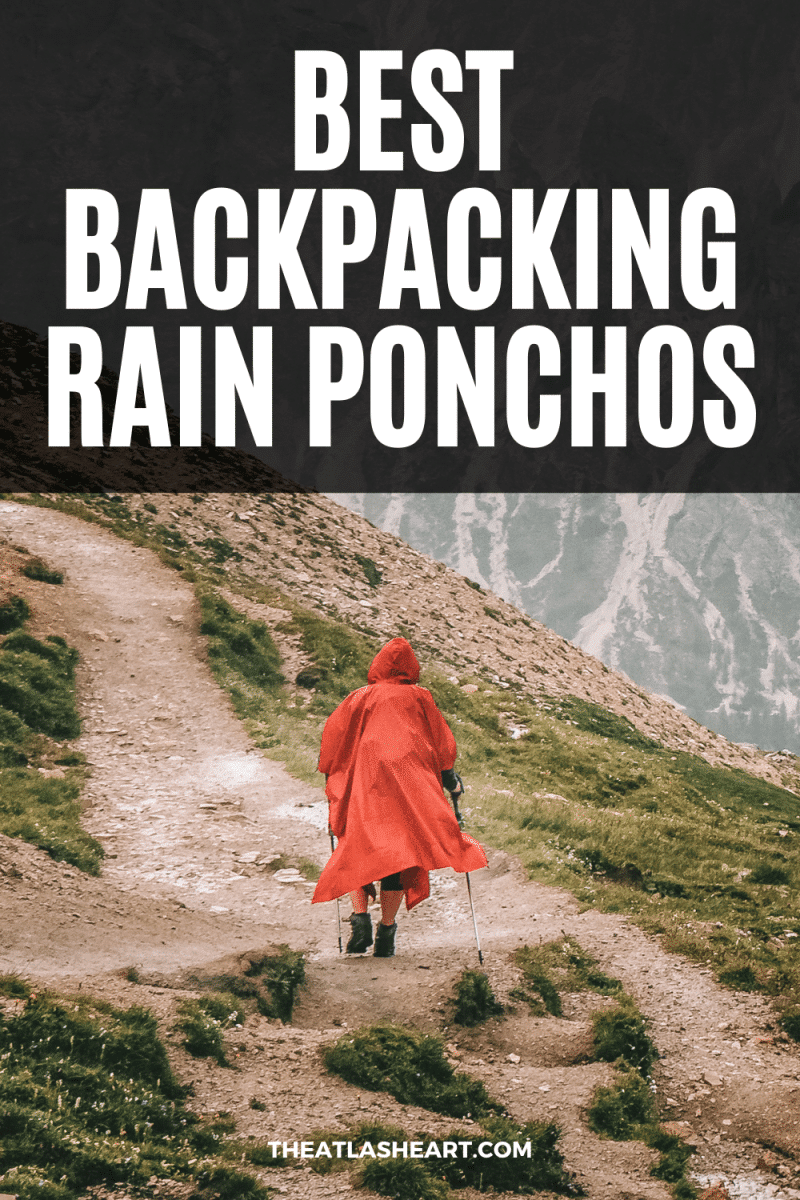
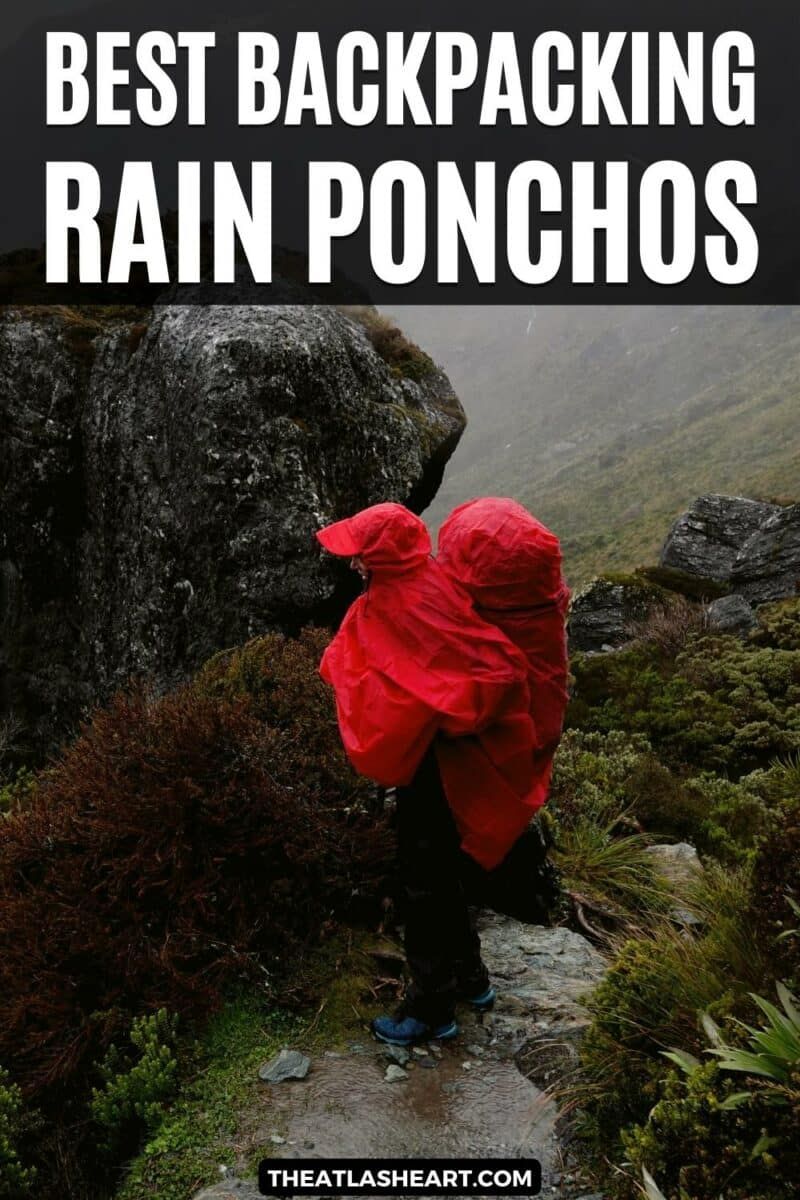
Pin one of these images for future reference

